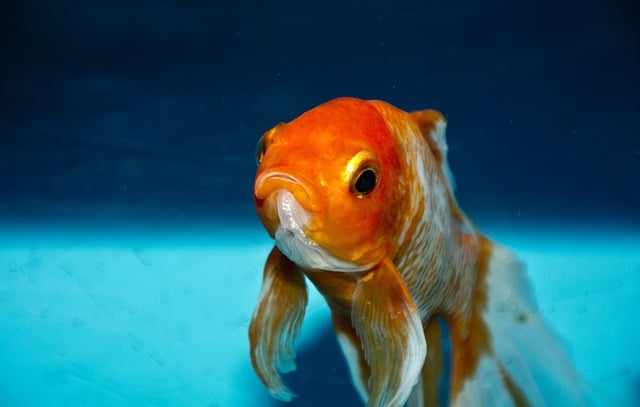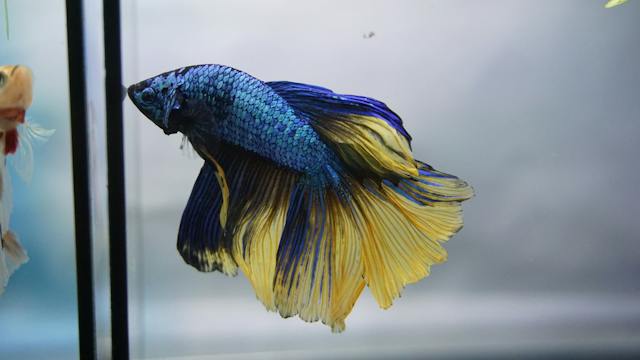Betta fish, also known as Siamese fighting fish, are a popular freshwater aquarium fish native to Southeast Asia. Their scientific name is “Betta splendens.”
In the wild, bettas live in stagnant pools, rice paddies, and slow-moving streams. They have long, flowing fins and are known for their vivid colors and aggressive behaviors.
Male bettas in particular are highly territorial and will flair their gills and fins when defending their space or attracting a mate.
Their aggressive nature is why they are named fighting fish. However, female bettas can live together peacefully in a sorority.
Bettas breathe air from the surface, have a labyrinth organ to extract oxygen, and can survive in low-oxygen environments.
They build bubble nests for their eggs. While bettas do not require a heater or filter, they thrive best in water between 74-82°F with places to hide. Their lifespan is around 2-3 years with proper care.
Overall, betta fish are a beautiful, interactive pet. Their flowing fins, bright colors, and bubble-nesting behaviors make them popular aquatic fish.
What is Goldfish?

Goldfish (Carassius auratus) is a popular freshwater aquarium fish native to eastern Asia. Belonging to the carp family, goldfish naturally live in slow-moving freshwater environments like ponds, lakes, and rivers.
Through years of domestication and selective breeding, goldfish exhibit colors and shapes far different from their olive-green wild ancestors.
Goldfish display interesting behaviors in captivity. They interact with each other, recognize their owners, and can even be trained to do simple tricks.
Most goldfish species are social and prefer to be kept in groups. Common behaviors include ‘greeting’ owners when they approach the tank, nibbling fingers, and chasing or playing with tankmates. Some goldfish enjoy having their scales rubbed.
Goldfish have simple care requirements compared to other aquarium fish. Given adequate space, filtration, and regular water changes, goldfish generally remain hardy and long-living pets.
Their gentle nature makes goldfish a popular choice for home aquariums.
Betta Fish Diet
Betta fish are carnivores that primarily eat insects and larvae in their natural habitat in rice paddies and slow-moving streams in Southeast Asia.
In the wild, bettas have access to diverse live foods including mosquito larvae, water fleas, brine shrimp, bloodworms, small snails, fly larvae, and winged insects that fall into the water.
This varied diet provides bettas with the protein, fats, and nutrients they need to thrive.
In captivity, betta fish can be fed a combination of high-quality prepared foods along with supplemental live and frozen foods.
Many betta keepers feed their fish an omnivorous flake or pellet formulated for bettas 2-3 times per day. These prepared foods contain fish meal, shrimp meal, spirulina, and wheat germ to provide balanced nutrition.
Bettas should also be offered freeze-dried bloodworms, brine shrimp, or daphnia a few times per week for variety.
Live foods like blackworms, wingless fruit flies, or baby brine shrimp can also be given occasionally to stimulate their natural hunting behaviors.
A nutritious and diverse diet is key to keeping betta fish healthy in an aquarium environment.
Goldfish Diet
Goldfish are omnivorous fish that eat both plant and animal matter. In the wild, goldfish feed on a diverse diet of aquatic plants, small crustaceans, insects, and insect larvae.
Their natural diet consists of foods rich in plant matter and fiber from sources like duckweed, waterweed, and algae.
When kept as pets in aquariums and ponds, goldfish benefit from a varied diet to mimic their natural feeding habits. Goldfish food options include:
– Flakes and pellets: Made from plant and animal proteins like fish meal, shrimp meal, spirulina, and wheat germ. Quality brands provide balanced nutrition.
– Veggies: Bits of fresh or frozen vegetables like peas, zucchini, spinach, and sweet potato provide fiber. Blanch tough veggies to soften.
– Live foods: Brine shrimp, daphnia, mosquito larvae offer enrichment and protein. Introduce them moderately as treats.
– Algae wafers are made from algae and carry the nutritional benefits of marine plants. Sink them for bottom-feeding fish.
Goldfish enjoy nibbling throughout the day and will eat until satiated. Give them only what they can consume within a few minutes, 2-3 times per day.
This prevents waste and water quality issues. Their diet should offer a good balance of proteins, carbohydrates, and vitamins to support optimum health.
Key Nutritional Requirements
When looking at whether it’s okay to feed a betta fish goldfish food, it’s important to understand the key nutritional requirements of each fish.
Though they are both freshwater fish, bettas, and goldfish have some different dietary needs.
Protein
– Bettas are carnivorous and require a high protein diet, preferably around 40% protein. They need protein from sources like fish meal, shrimp meal, and insect meal.
– Goldfish are omnivorous and require moderate protein levels, ideally 25-35%. They can obtain protein from fish meal as well as plant sources like spirulina.
Fat
– Bettas need lower fat levels, less than 5%, as excess fat can cause health issues.
– Goldfish require higher fat content, around 5-10%, which provides them energy.
Fiber
– Bettas do not need much fiber since they are carnivores. Too much fiber can cause digestion issues.
– Goldfish benefit from some vegetable matter and fiber from ingredients like spirulina or seaweed.
Vitamins
– Important vitamins for bettas include Vitamin C and the B vitamins.
– Goldfish also need Vitamin C and B vitamins, as well as carotenoids for coloration.
Understanding the different nutritional requirements allows us to better evaluate if substituting goldfish food could meet a betta’s needs or cause issues.
Key considerations are the protein content and quality, fiber levels, and Vitamin C.
Comparing Betta and Goldfish Foods
Betta fish and goldfish have some similar nutritional requirements, but there are also key differences between these two fish that require different ingredients and formulations for their foods. Here’s an overview of how these foods differ:
– Protein levels: Bettas are carnivorous fish that require higher protein diets around 40% protein or more. Goldfish are omnivores that need less protein in the range of 25-35%. Betta foods will contain higher protein ingredients like fish meal.
– Plant ingredients: Goldfish do well with some plant materials in their diet like spirulina and vegetable matter. Betta fish do not digest plant matter as easily and do better with higher meat content.
– Starch ingredients: Goldfish foods often contain wheat flour, rice, and starch binders. Bettas cannot digest these effectively, so betta foods rely more on insect meals for carbohydrates.
– Fiber content: Betta foods have little to no fiber, while goldfish foods contain around 5% fiber from ingredients like spirulina and kelp. The fiber helps promote digestion in goldfish.
– Vitamin C: Goldfish require vitamin C in their diet, while bettas have a low need for it. Vitamin C sources like seaweed meal are standard in goldfish food.
– Feeding frequency: Bettas have slower digestion and are typically fed once or twice a day. Goldfish can be fed smaller meals 2-3 times per day. Foods are formulated accordingly.
So, betta and goldfish foods contain different ingredients, nutrients, and formulas to meet the needs of these unique fish species.
It’s important to feed them the appropriate food to support their health. Goldfish food would be nutritionally imbalanced and improper for betta fish.
Risks of Feeding Goldfish Food
Goldfish food can potentially harm betta fish if fed regularly over time due to some key nutritional differences between the two fish. Here are the main risks to be aware of:
– Excess Protein Content: Many goldfish foods contain higher levels of protein than bettas require.
While bettas only need around 25-35% protein in their diet, goldfish foods often have 40% protein or more. Too much protein can lead to liver and kidney problems in bettas over time.
– Lack of Fiber: Bettas need a certain amount of vegetable matter and fiber in their diet to support digestion.
Goldfish foods, on the other hand, are formulated for omnivorous fish and often lack adequate fiber sources. This can cause digestive issues in bettas.
– Nutritional Imbalances: In addition to excess protein and inadequate fiber, goldfish foods also differ in vitamins, minerals, and amino acid balances.
They lack the specialized formulation that betta-specific foods have to meet bettas’ unique nutritional requirements.
– Unhealthy Ingredients: Lower-quality goldfish foods may contain cheap fillers, artificial colors, preservatives, and other additives that are not ideal for bettas’ long-term health. Betta foods are tailored to their natural habitats and preferences.
– Swim Bladder Disorder: The higher protein and fat content in goldfish food can also increase the risk of swim bladder problems in bettas when fed as a staple diet.
This can cause issues like buoyancy problems, constipation, or difficulty swimming.
Overall, while goldfish food can occasionally be fed as a treat, it does not provide ideal full nutrition for bettas.
Sticking to a high-quality betta diet will be healthier for them in the long run.
Monitor bettas closely for signs of malnutrition or digestive issues if goldfish food becomes a regular part of their feeding. Adjust their diet accordingly for their health and well-being.
Benefits of Feeding Goldfish Food
There are potential benefits to feeding goldfish food to betta fish in moderation. Some considerations:
– Goldfish foods often contain high protein levels, which bettas require in their diet. Bettas are carnivores and need protein from ingredients like fish meal.
– Goldfish foods can provide variety. Alternating between betta food and small amounts of goldfish food can add diversity to the betta’s diet.
– Some goldfish foods contain beneficial supplements. Bettas may gain nutrients like vitamins C and D from goldfish flakes or pellets enhanced with these supplements.
– Goldfish foods are readily available. While specialized betta diets are ideal, goldfish foods can offer an alternative if betta food is unavailable. This allows betta owners to still provide proper nutrition.
However, there are risks to relying on goldfish food as a dietary staple for bettas long-term, which we’ll explore more in the next section.
The key is moderation – goldfish food can supplement a betta’s diet in small amounts but should not completely replace betta-specific foods optimized for their nutritional needs.
Best Practices
Betta fish have specific dietary needs that must be met to keep them healthy and active. Here are some best practices for feeding your betta fish:
– Offer a variety of foods: Bettas are omnivores and need both plant and animal matter. Feed a mix of quality pellets, flakes, frozen and freeze-dried foods. This provides balanced nutrition and prevents boredom.
– Look for high protein content: Bettas are carnivores and require at least 40% protein in their diet. Choose foods with fish, shrimp, insects, or other animal proteins as the first ingredients.
– Feed small portions 2-3 times per day: Bettas have small stomachs and do best with several small meals instead of one large meal. This also helps prevent waste and water quality issues.
– Soak dry foods before feeding: Dry pellets and flakes will expand in water. Soak before feeding to prevent bloating and constipation.
– Supplement with treats: Occasionally supplement with frozen bloodworms, brine shrimp, or daphnia for variety. But treats should not exceed 10% of the total diet.
– Fast 1 day per week: Bettas are prone to constipation and obesity. A regular fast day helps promote good digestive health.
– Avoid overfeeding: Only feed amounts that can be consumed in 2-3 minutes, and remove any excess food. Uneaten food fouls the water.
– Maintain water quality: Perform regular water changes and test water parameters. Poor water quality can lead to disease and appetite loss.
By following these best practices, you can optimize your betta’s nutrition and keep them thriving in captivity. Proper diet is crucial for good health and longevity.
Conclusion: Can Bettas Eat Goldfish Food?
Whether bettas can eat goldfish food comes down to the specific ingredients and nutrition profile of the goldfish food.
While goldfish and bettas have some overlap in their dietary needs, there are also key differences that need to be considered.
Goldfish foods are generally higher in plant matter and carbohydrates than ideal betta foods. The high fiber content can cause digestive issues in bettas.
Bettas are carnivores that need high-protein foods with some plant matter for fiber. Too many carbs and filler ingredients can lead to bloating.
However, some high-quality goldfish pellets with good protein content from fish meals and wholesome ingredients may be suitable for bettas occasionally. This is a better option than lower-quality betta pellets full of fillers.
When feeding goldfish food to bettas, only feed a small amount 1-2 times per week maximum. Watch for signs of digestive upset like bloating. Soaking pellets can help reduce air swallowing.
For optimal betta health and nutrition, it’s still best to feed a high-protein betta formula as the staple diet. But in a pinch, higher-quality goldfish pellets can work. Avoid flake foods which bettas may struggle to eat.
In summary, feeding goldfish food to bettas once in a while is possible but not ideal long-term. Choose a premium pellet formula and feed sparingly, watching for signs of digestive issues. A proper betta diet remains essential for health.

